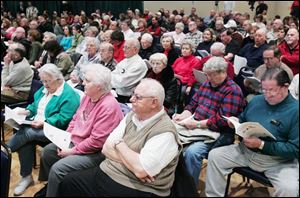
Sylvania-area residents mull merger
2/15/2007
A large crowd hears about the potential financial impacts of a merger proposal for Sylvania and Sylvania Township.
As Sylvania-area residents review the new merger study, questions are surfacing about what role voters would play in the process and how long it might take to decide whether to combine the city and township.
Although the merger process isn't particularly complicated, it is lengthy. Officials predicted it could be several years before Sylvania and Sylvania Township settle the issue.
The first step in the merger process involves circulating petitions that would include names of at least five people from the city and from the township who would be willing to serve on the merger commission.
Petitions must be signed by at least 10 percent of the voters in the city and township, based on the number of voters in the last gubernatorial election, according to information from the Urban Affairs Center at the University of Toledo.
A study by the center on the financial impacts of a township and city merger was released to the public last week.
If merger petitions are validated by the board of elections, the issue would go on the ballot in the next general election that occurs at least 75 days after petitions are filed.
Before the election, township trustees and city council must each hold a public meeting to explain their positions on the proposal.
Voters would then decide whether to create a merger commission; the ballot would include names of commission nominees.
"It's a big task," said Councilman Doug Haynam. "You need to get people who are willing to serve on the merger commission. We're fortunate that we have very talented people in the community who could serve as commission members."
The commission would be formed only if residents in both the township and the city agree.
If it is approved, the commission would set conditions of a merger, which would then be submitted to voters at the second general election after the merger commission election, according to information from the Urban Affairs Center.
The conditions must be approved by voters in both the township and the city, and if that would occur, the merger would become effective the following January.
Voter rejection of the merger issue by either city or township residents would end the process, and no merger petitions could be submitted for three years.
If residents move the process forward soon, a tentative timetable could be as follows: merger commission formation vote, November of this year; commission report completed, August, 2008; and vote on the commission's proposal, November, 2009.
Sylvania Township Trustee DeeDee Liedel said the community needs to take time to review the study and discuss the issue.
"We need to have the opportunity for our residents to speak out," she said. Nonfinancial issues, such as government regulations that might be imposed under a new city form of government, need to be discussed as well, she said.
Another public meeting to discuss the merger study will be held at 7 p.m. March 1 in the Sylvania Senior Center, 7140 Sylvania Ave.
Financial changes as a result of a merger could generate an additional $12 million a year in income tax revenue and could save residents and businesses nearly $9 million in property taxes a year, according to the study. Additional services, estimated at $5.2 million, could be offset by a municipal income tax, service fees, special assessments, and existing levies.
Sylvania Councilman Keith Haddad said figures in the study sound favorable, and he's pleased that the report spells out what needs to be done if the two entities want to pursue a merger.
"I think a merger would save the city and the township money," he said, adding that "a merged community would have a lot more clout."